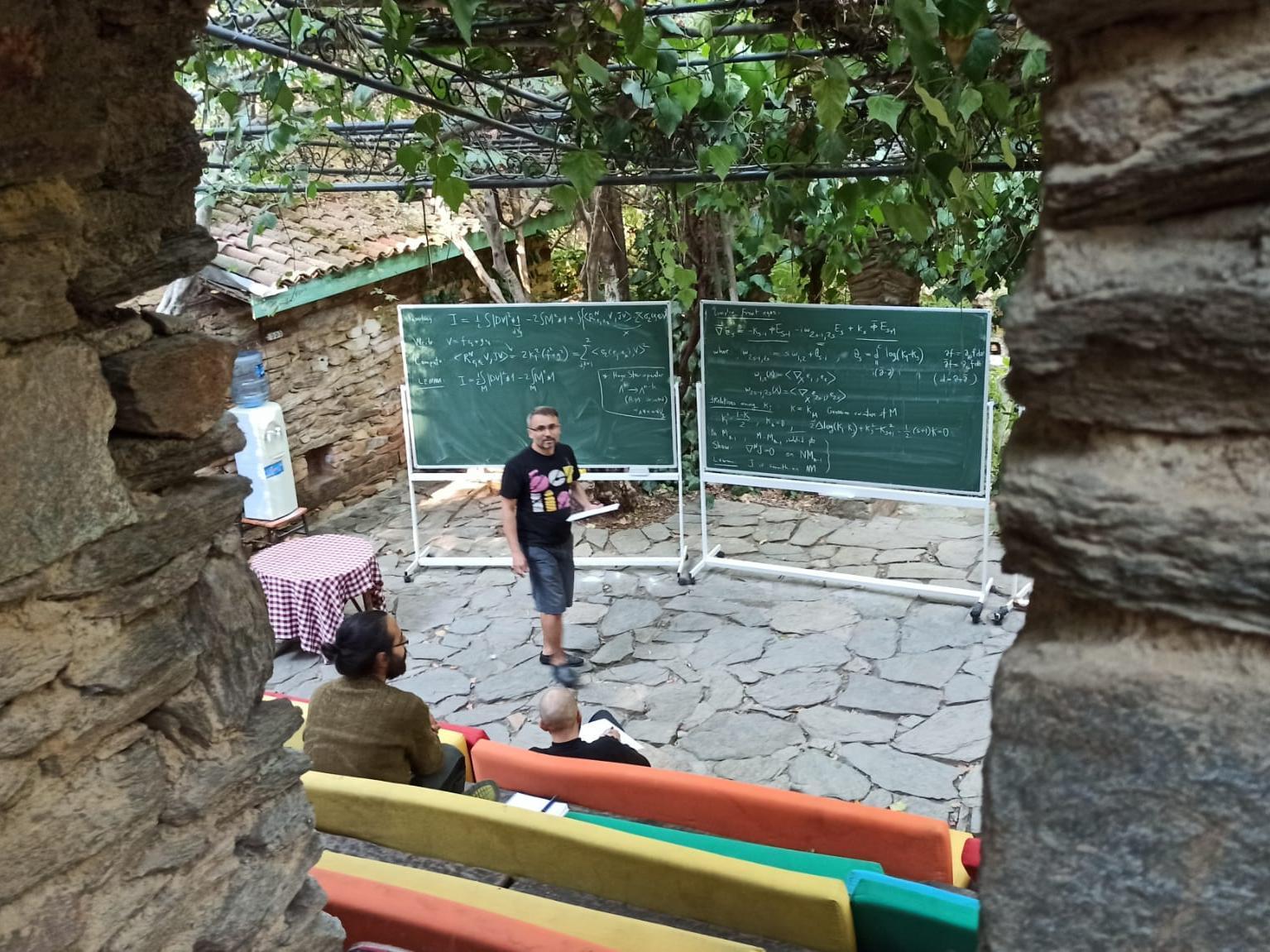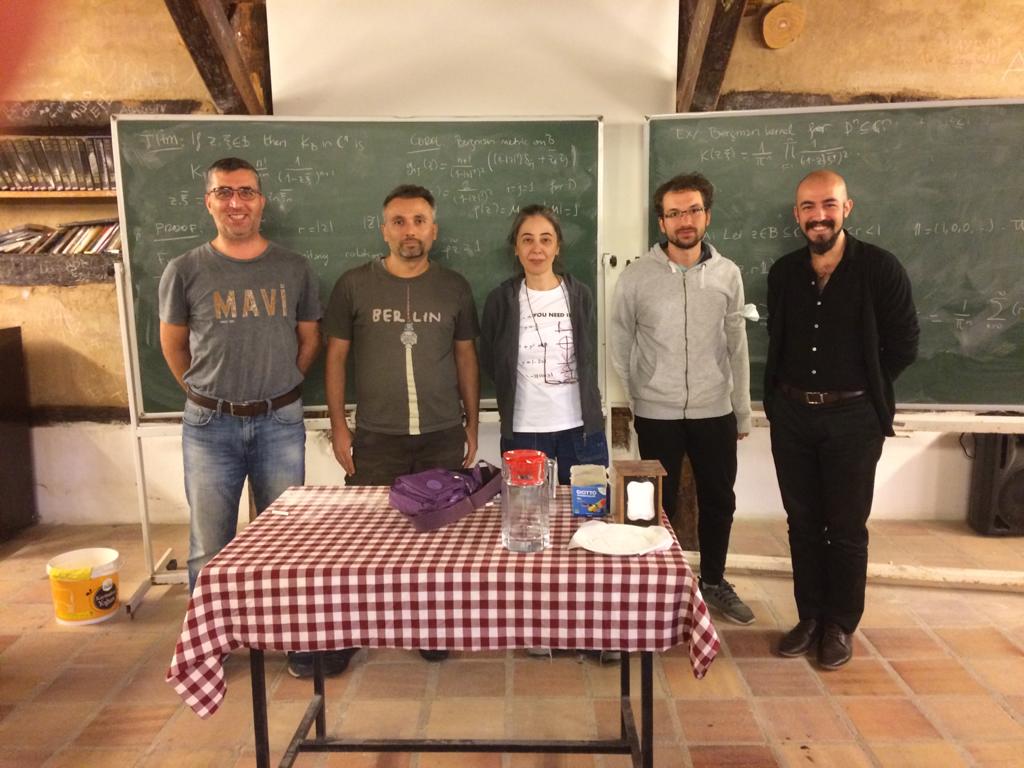| Geometry Main |
The 7th GTSSGEOMETRY-TOPOLOGY SUMMER SCHOOL Nesin Mathematics Village, Şirince, İzmir
|
| TIME | SPEAKER | TITLE |
| Sep 13-17 9-11 |
Eyüp Yalçınkaya |
Spin(7) Geometry
|
| Sep 13-17 11-1 | Buket Can Bahadır | Special Metrics in Complex Analysis | Lunch Time |
| Sep 13-17 2:30-4 |
Mustafa Kalafat |
Introduction to Minimal Surfaces
|
Second Week
| TIME | SPEAKER | TITLE |
| Sep 20-25 9-11 |
Özgür Kelekçi
| Introduction to Riemannian Geometry
|
| Sep 20-24 11-1 |
Hamid Rahkooy | Introduction to Toric Varieties | Lunch Time |
| Sep 20-24 2:30-4 |
Mustafa Kalafat |
Riemann Surfaces in Einstein-Hermitian Spaces
|
| Sep 20-24 4-6 |
Buket Can Bahadır
| Bergman Metric in Complex Analysis
|
Scientific Commitee
Organizing Commitee
| Mustafa Kalafat | Nesin Mathematical Village |
| Özgür Kelekçi | Turkish Aeronautical Association University |
| Eyüp Yalçınkaya | Tübitak |




Information
The 7th GTSS will be held at the
Nesin Mathematical Village
in Şirince, İzmir.
There will be about 15 mini-courses of introductory nature, related to the Geometry-Topology research subjects.
In the middle of the week there is an excursion to the Ancient City of Ephesus and/or Kuşadası Beach.
Wifi info: Passwords are TermoS1! at the Library (Kutuphanegenel) networks, zeytinlik for istasyon and kurugolet,depoevler,dasevler for kisbahcesi at the registration lobby.
Application
Graduate students, recent Ph.D.s and under-represented minorities are
especially encouraged to the summer school.
Partial financial support is available. Daily expenses including bed, breakfast, lunch, dinner is around 20€.
Please fill out the application form to attend to the summer school.
Airport: İzmir Adnan Menderes Airport - ADB is the closest one.
For pick up, faculty is advised to get out of the terminal building from the domestic gate and wait there.
Also let us know before hand, your whatsapp number and/or Google-Hangouts address in case of a problem.
Small amounts of Turkish Lira may be needed in the village
which you can withdraw from ATM machines at the airport or tell the driver along the way.
In case you are coming to the Village independently, from the Airport you may take the regional trains to Selçuk,
possibly with a break at Tepeköy. Then from Selçuk take a taxi which costs about 10€.
Taxi Drivers: +90 232 892 3125 (Gar Taxi), +90 553 243 0835 (Volkan), +90 532 603 1518 (Ata).
Visas: Check whether you need a visa beforehand.

Abstracts
Minimal surface theory originates with Lagrange who in 1762 considered the variational problem of finding the surface z = z(x, y) of least area stretched across a given closed contour. He derived the Euler–Lagrange equation for the solution He did not succeed in finding any solution beyond the plane. In 1776 Jean Baptiste Marie Meusnier discovered that the helicoid and catenoid satisfy the equation and that the differential expression corresponds to twice the mean curvature of the surface, concluding that surfaces with zero mean curvature are area-minimizing.
By expanding Lagrange's equation, Gaspard Monge and Legendre in 1795 derived representation formulas for the solution surfaces. While these were successfully used by Heinrich Scherk in 1830 to derive his surfaces, they were generally regarded as practically unusable. Catalan proved in 1842/43 that the helicoid is the only ruled minimal surface.
Progress had been fairly slow until the middle of the century when the Björling problem was solved using complex methods. The "first golden age" of minimal surfaces began. Schwarz found the solution of the Plateau problem for a regular quadrilateral in 1865 and for a general quadrilateral in 1867 using complex methods. Weierstrass and Enneper developed more useful representation formulas, firmly linking minimal surfaces to complex analysis and harmonic functions. Other important contributions came from Beltrami, Bonnet, Darboux, Lie, Riemann, Serret and Weingarten.
Between 1925 and 1950 minimal surface theory revived, now mainly aimed at nonparametric minimal surfaces. The complete solution of the Plateau problem by Jesse Douglas and Tibor Radó was a major milestone. Bernstein's problem and Robert Osserman's work on complete minimal surfaces of finite total curvature were also important.
Another revival began in the 1980s. One cause was the discovery in 1982 by Celso Costa of a surface that disproved the conjecture that the plane, the catenoid, and the helicoid are the only complete embedded minimal surfaces in R^3 of finite topological type. This not only stimulated new work on using the old parametric methods, but also demonstrated the importance of computer graphics to visualise the studied surfaces and numerical methods to solve the "period problem" (when using the conjugate surface method to determine surface patches that can be assembled into a larger symmetric surface, certain parameters need to be numerically matched to produce an embedded surface). Another cause was the verification by H. Karcher that the triply periodic minimal surfaces originally described empirically by Alan Schoen in 1970 actually exist. This has led to a rich menagerie of surface families and methods of deriving new surfaces from old, for example by adding handles or distorting them.
Currently the theory of minimal surfaces has diversified to minimal submanifolds in other ambient geometries, becoming relevant to mathematical physics (e.g. the positive mass conjecture, the Penrose conjecture) and three-manifold geometry (e.g. the Smith conjecture, the Poincaré conjecture, the Thurston Geometrization Conjecture).
In this lecture series we will give an introduction to some topics in minimal submanifold theory. The topics to be covered are as follows.
- Mean curvature vector field on a Riemannian submanifold.
- First variational formula for the volume functional.
- Second variation of energy for a minimally immersed submanifold.
- Stability of minimal submanifolds.
References:
Li, Peter. Geometric analysis. Cambridge University Press, 2012.
According to the Berger classification (1955), the Spin(7) group is one of these holonomy classes. Firstly, it is presented its properties. After that, torsion which is another important term in superstring theory will be geometrically introduced and related to Spin(7) geometry. Let M be an 8-dimensional manifold with the Riemannian metric g and structure group G ⊂ SO(8). The structure group G ⊂ Spin(7), then it is called M admits Spin(7)-structure.
M. Fernandez [1] classifies all types of 8-dimensional manifolds admitting Spin(7)-structure. In general, torsion-free Spin(7) manifold are studied considerably. On the other hand, manifolds admitting Spin(7)-structure with torsion have rich geometry as well. Locally conformal parallel structures have been studied for a long time with Kähler condition being the oldest one. By means of further groups whose holonomy is exceptional, the choices of the G_2 and Spin(7) deserves attention.
Ivanov [3], [4], [5] introduces a condition when an 8-dimensional manifold admits locally conformal parallel Spin(7) structure. Salur and Yalcinkaya [6] studied almost symplectic structure on Spin(7)-manifold with 2-plane field. Then, Fowdar [2] studied Spin(7) metrics from Kähler geometry.
In this research, we introduce an 8-manifold equipped with locally conformal Spin(7)-structure with 2-plane field. Then, almost Hermitian 6-manifold can be classified by the structure of M.
References:
- M. Fernandez, A Classification of Riemannian Manifolds with Structure Group Spin (7),
Annali di Mat. Pura ed App., vol (143), (1986), 101—122. - U. Fowdar Spin(7) metrics from Kähler Geometry,
Arxiv:2002.03449, (2020). - S. Ivanov, M. Cabrera, SU(3)-structures on submanifolds of a Spin(7)-manifold,
Differential Geometry and its Applications, V 26 (2), (2008) 113–132. - S. Ivanov, M. Parton and P. Piccinni, Locally conformal parallel G 2 and Spin(7) manifolds.
Mathematical Research Letters, V 13, (2006), 167–177. - S. Ivanov Connections with torsion, parallel spinors and geometry of Spin(7) manifolds.
Arxiv math/0111216v3. - S. Salur and E. Yalcinkaya Almost Symplectic Structures on Spin(7)-Manifolds,
Proceedings of the 2019 ISAAC Congress (Aveiro, Portugal), 2020.
Level: Undergraduate, graduate
RS 1: Jacobi Operator. Higher dimensional fundamental forms.
RS 2: Higher dimensional curvatures.
RS 3: Minimal immersions into higher spheres.
RS 4: A Hermitian structure on the normal bundle.
RS 5: An application of the Riemann-Roch formula to the minimal surfaces.
RS 6: Index of minimal immersions of a sphere into higher dimensional spheres.
RS 7: Holomorphic curves in the 6-dimensional sphere.
We will be using the following resources.References:
- N. Ejiri - The Index of Minimal Immersions of S^2 into S^{2n}.
Mathematische Zeitschrift. (1983). - Kühnel, Wolfgang - Differential geometry. Curves—surfaces—manifolds. Third edition.
Translated from the 2013 German edition. American Mathematical Society. 2015. - J. Madnick - The Second Variation of Null-Torsion Holomorphic Curves in the 6-Sphere.
ArXiv:2101.09580 (Jan 2021) 35 pages. - J. Madnick - Free-Boundary Problems for Holomorphic Curves in the 6-Sphere.
Arxiv:2105.10562 (May 2021). 17 pages. - S. Montiel and F. Urbano - Second Variation of Superminimal Surfaces into Self-Dual Einstein 4-Manifolds.
Trans. AMS. (1997).
Toric Varieties are important objects in algebraic geometry that have been studied extensively. They have many interesting combinatorial properties and arise in many applications. In this course we give an introduction to toric varieties. The audiance is required to have background in algebra and some basic algebraic geometry notions. Our main source is Fulton’s book Introduction to Toric Varieties.
Prerequisites: Undergraduate algebra and some basic notions of algebraic geometry.
Level: 3rd/4th year undergrad and graduate students
We want to introduce some important metrics in both complex analysis and geometry with a simple set up and minimum background requirements, so that the students can have a more concrete feeling of the geometry of these metrics rather than perceiving them as some abstract theoretical concepts. To this end, we want to define and explore some properties of spherical, hyperbolic, Caratheodory and the Kobayashi metrics on the unit disc in the complex plane. Syllabus:
1- Complex Analysis and Differential Geometry Background
2- The Poincare Metric and Schwarz Lemma
3- Curvature, Liouville’s Theorem and Other Applications
4- Normal Families and the Spherical Metric
5- The Caratheodory and the Kobayashi Metric
6- A Word About Several Complex Variables (if time permits)
Textbook or/and course webpage (not necessary): SG Krantz, Complex analysis: the geometric viewpoint, American Mathematical Soc., 2004
Prerequisites: Some basic understanding of Complex Variables (undergraduate level)
Level: Graduate, Advanced undergraduate
Bergman kernel and metric have been important tools for function theory, analysis, differential geometry, and partial differential equations. We want to explore how to construct these tools by building up on a simple idea: "square integrable analytic functions on a bounded domain in a complex space form a very well behaved space". This space is called Bergman space. Our goal is to look at some of the basic analytic and geometric aspects of Bergman’s theory with a simple set up. Syllabus:
1- Introduction to Bergman Kernel and Basics
2- Invariance Properties of the Bergman Kernel
3- How to Calculate the Bergman Kernel- Conformal Invariance, Orthonormal Systems
4- How to Calculate the Bergman Kernel- Differential Equations
5- The Bergman Metric
6- What happens in Several Complex Variables (if time permits)
Textbook or/and course webpage (not necessary): SG Krantz, Complex analysis: the geometric viewpoint, American Mathematical Soc., 2004; SG Krantz, Geometric analysis of the Bergman kernel and metric, Springer, 2013
Prerequisites: Some basic understanding of complex variables and some basic background in real and functional analysis
Level: Graduate, Advanced undergraduate
This will be a gentle introduction to Riemannian geometry. Basic building blocks will be explained, and some explicit computations will be done on concrete examples which may be useful for graduate students.
1. Topological manifold, differentiable manifolds.
2. Tangent space, Tangent bundle
3. Riemannian metrics
4. Riemannian connection, fundamental theorem of Riemannian geometry
5. Curvature tensor, curvature form
6. Spin connection, some computation examples


|

|
Activities are supported by Nesin Mathematical Village and Turkish Mathematical Society
